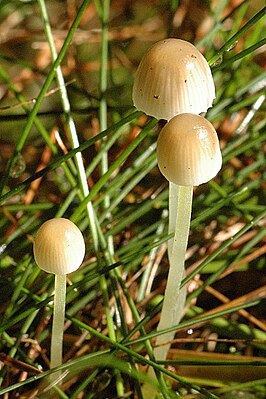Conical helmling
| Conical helmling | ||||||||||||
|---|---|---|---|---|---|---|---|---|---|---|---|---|

Kegeliger Helmling ( Mycena metata ) |
||||||||||||
| Systematics | ||||||||||||
|
||||||||||||
| Scientific name | ||||||||||||
| Mycena metata | ||||||||||||
| ( Fr. ) P.Kumm. |
The conical or flesh-brownish helmling ( Mycena metata ) is a type of mushroom from the genus of the helmlings ( Mycena ).
features
Macroscopic features
The fruit bodies are very small to small. The hat is 1.0 to 2.2 cm wide, narrow to wide, conical, translucent-striped and slightly hunched, a grooving continues to the middle of the hat. He is hygrophan . The center can be described as button-like and clearly pointed. Possible colors are white and beige to matt brown. The surface of the hat and the brim are smooth and dry. The lamellae are narrow, thin, matt white to beige and sometimes pink. The spore print is whitish.
The fragile stem is approximately 4 to 8 inches long, 0.10 to 0.25 cm thick, and hollow. Its texture is velvety. The base of the stem is covered with long, white fibrils, their color is similar to that of the hat and brightens towards the top. The meat is soft and spongy, and when viewed it appears glassy.
Microscopic features
The spores are 7–9.5 × 3.5–4.5 µm in size and hyaline . Its surface is smooth, the shape is broadly ellipsoid. They are amyloid. The basidia are 2 or 4 spore. The thin-walled cheilocystids are club-shaped or spindle-shaped.
Distribution and ecology
The conical helmling occurs mainly in Europe. It has also been detected in North America and Greenland. The frequency is to be estimated high, the continental distribution area is large.
The saprotrophic species prefers to inhabit mossy forest areas. The habitat includes light locations under conifers and deciduous trees. The fruiting body grows very numerous on needle beds, such as those of the spruce ( Picea ) and is transient. Other plant residues, in particular that of conifers (cones), manure and dung can be other nutrient media . The fruiting bodies can be found from summer to late autumn.
use
The species is not an edible mushroom and, like all known species of the genus Mycena, is inedible.
swell
- Giovanni Robich (2003), Associazione Micologica Bresadola: Mycena d'Europa
- https://mycena.no/metata.htm
- Reports of the Natural Science-Medical Association in Innsbruck, Wagner University Publishing House (1910) - Volumes 32–34
Individual evidence
- ↑ http://www.mycobank.org/Biolomics.aspx?Table=Mycobank&MycoBankNr_=248026
- ↑ Michigan. Geological Survey (1918), The Survey Biological series, Volume 5, Volume 1, p. 805
- ↑ a b Michael Jordan (2004), frances lincoln ltd: The encyclopedia of fungi of Britain and Europe. P. 168. ISBN 0711223785
- ^ Arctic and Alpine Mycology 6, Museum Tusculanum Press. p. 145 ISBN 8763512777
- ↑ Edmund Michael, Hanns Kreisel (1983), G. Fischer Verlag: Handbuch für Pilzfreunde (Volume 1). P. 30